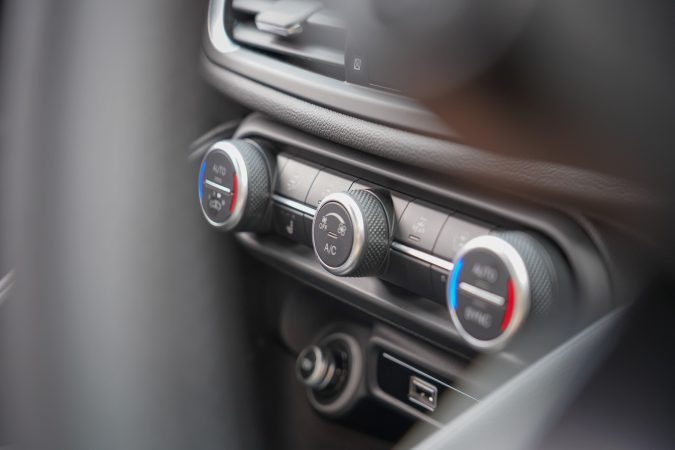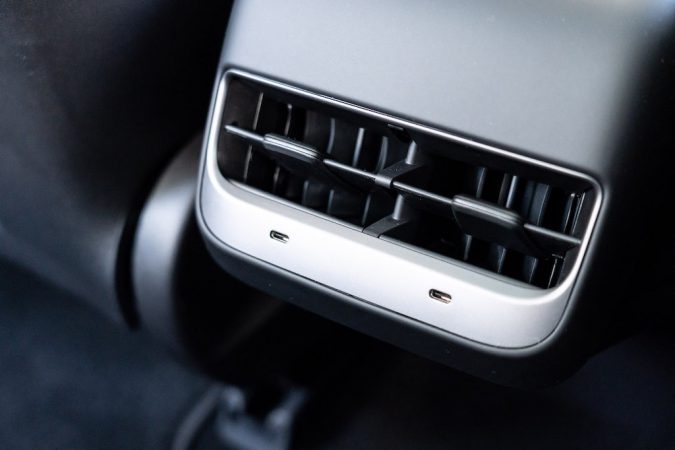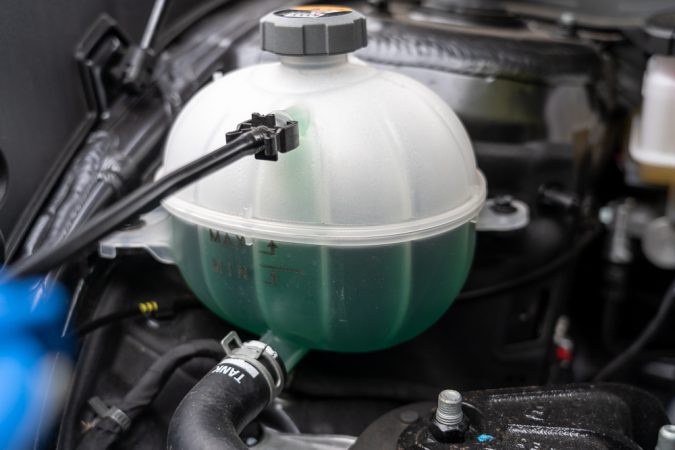If you’re having a coolant leak problem, you might have heard the term “bypassed heater core”. Depending on where the leak is coming from, a bypassed heater core might just be the solution for you. But what is it? How do you do it? And more importantly, should you do it? That’s what we’re going to answer in this post. By the end of this post, you’ll know everything you need to know about bypassed heater core.
What’s A Heater Core?
The heater core is a part of your car’s HVAC and engine cooling system. We’ll need to explain what the heater core is first before we get into bypassing heater cores.
The heater core is essentially a small radiator that’s connected to the car’s cooling system. When you turn on the heater in your car, the system will divert some of the hot coolants to the heater core. Then as hot coolant is passing by, the heater core will turn warm, and a fan blows air through it. And of course, the air turns warm.
The warm air coming from the heater core then goes into your car’s air conditioning vents, and voila! You have hot air in your car’s cabin to keep you warm during those cold winter days. So, as the name suggests, the heater core is the main component in your car’s heater. It utilizes the hot coolant from your car’s cooling system to keep you and your passengers warm.
So Why Would I Need To Bypass My Heater Core?
Bypassing the heater core may be necessary when there’s a leak in the core. The heater core – much like the cooling system’s radiator – can develop a hole over time, leading to coolant leaking out. Not only the heater won’t work leaving you cold during the winter, but this also means your car will lose coolant.
When your car loses coolant, the cooling system will be less efficient in cooling the engine. This is because of two reasons: first, without enough coolant, the system won’t be able to carry as much heat away from the engine as it normally would. This will then result in the engine overheating. And needless to say, an overheating engine isn’t good. You can damage various components inside the engine, costing thousands of dollars to fix.
The second reason is that a hole in the system will reduce pressure inside the system. The cooling system needs pressure to operate properly. Without the appropriate amount of pressure, the system won’t cool the engine as efficiently. So, why bypass the heater core?

Bypassing the heater core is an option if you don’t feel like replacing the heater core. The process entails removing the heater core and then connecting the inlet and exit hose that connects to the heater core. This removes the leaking core, and your car’s cooling system will work just fine afterward.
So I Don’t Need To Replace It?
Yes, you can get away with not replacing your heater core. But this is basically a botch job to keep your car running smoothly while keeping repair costs to a minimum. As you’ll learn later on, the replacement cost for a heater core is very expensive. So, bypassing the heater core instead of replacing it is a great way to reduce costs.
Of course, this comes with one major downside: your car won’t have a heater core, meaning you won’t have a heater in the car. This isn’t a big deal if you live somewhere that’s warm all year round, like California. But if you live in an area that gets cold, such as North Dakota for example, then you’ll have to cope with the cold without a heater.
That being said, if you normally don’t use the heater in your car anyway, then you can ignore the downside. But first, let’s make sure that it’s actually your heater core that’s the problem before we get to how to bypass the heater core:
Signs Of Bad Heater Core
If you’re reading this, chances are you already went to the repair shop and your mechanic already told you that you may need to bypass the heater core. And now you want to make sure so you don’t get ripped off. Understandable, it never hurts to be an informed customer.
To verify if you have a bad heater core, watch out for these signs:
1. Heater Isn’t Working Normally
The first sign will obviously be the heater not working normally. If the heater core develops a hole, the hot coolant will escape through the core. This means the heater core won’t be as warm, since the coolant is leaking. As a result, when the fan blows air through the core, the resulting air won’t be as warm as it normally would be.

Of course, this isn’t the only reason why the heater isn’t working. It’s possible that the blower fan isn’t working properly, so the air isn’t blowing strong enough and the heater don’t feel as warm. Or it’s also possible that there’s an electrical issue, leading to the heating system not responding when you turn it on.
It’s also possible that you have a clogged heater core, in which case you need to flush it, rather than bypassing it entirely. So, to make sure that it’s the heater core, watch out for these other signs as well:
2. There’s Coolant Inside The Car
The heater core sits behind the dashboard of your car. So, when it leaks, the coolant is likely to enter your car’s interior. Check if there’s a coolant stain on your front carpets. If you see any, then it’s a good time to consider that bypassed heater core option.
3. Coolant Smell Inside The Car
It’s possible that when the coolant leaks from the heater core, it won’t immediately enter your car’s interior. It could be because the dashboard is very tightly sealed, preventing coolant from dripping inside. Or it’s also possible that your heater core is still in the early stages of failure, so not a lot of the coolant is dripping.
In this case, you should watch out for the smell of coolant. Coolant typically has a sweet, almost fruity smell. If you smell this inside your car, it would be wise to check the heater core’s condition.
4. Your Windows Fog Up
If enough coolant is leaking out, you may experience the windows fogging up (which might help if you figure out how to defog windshield). Enough coolant can form a mist that will coat your windows. Not only this is going to be hard to wash off, but it’s also rather dangerous. One of the main ingredients in the coolant is ethylene glycol, and this can be harmful to your health.
Breathing in ethylene glycol is unlikely to be fatal, but it can still irritate the eyes and cause respiratory tract irritation. Not exactly pleasant. While we’re at it, if you have kids, do not let them taste the coolant if it seeps into your interior. Coolant has a sweet smell and taste, and while it seems pretty dumb, kids put all sorts of things in their mouths, especially if it’s sweet. Ingesting ethylene glycol will affect the central nervous system, the heart, the kidneys, and can potentially be fatal.
5. Overheating Engine
And finally, since coolant will leak out of a bad heater core, this can lead to the engine overheating. If you see all the symptoms above and you notice the temperature gauge rising, you likely have a heater core problem.

To verify the problem, check your coolant level. You can do this by locating the coolant reservoir tank, and see if the coolant is at least at the minimum level indicator. In some cars, you may have to open the reservoir tank to see the indicator. If it’s below the minimum level, then you have a coolant leak. Coolant can also evaporate, but not enough that it will lose so much that it goes below the minimum level.
Afterward, check if there are any leaks in the engine bay and underneath the car. Keep a lookout for green or bright red fluid, if you see any in the engine bay or underneath the car, it’s possible that your heater core is not the problem. Remember, a bad heater core usually leaks coolant into the interior.
If the coolant leak is in the engine bay or underneath it, then the leak is coming from a different component in the cooling system. This may come from a cracked hose, a faulty radiator cap, or a bad coolant pump amongst other things. We wrote a great article about troubleshooting a coolant leak, and you can read about it here.
How To Bypass Heater Core
There are two ways of doing this: removing the heater core entirely, or leaving it in place and connecting the hoses with a PVC tube. The former is the ideal way to do it since if you want to replace the heater core in the future, you won’t need to replace the hoses.
Meanwhile, the latter is the easier option. But you may need to cut the current hoses that connect to the heater core. This means when you do want to replace the heater core, you will need to purchase new hoses along with it. They’re usually quite cheap, at around $10 each, but nevertheless, it will add more cost to the repair bill.
We’d like to note that the first way of bypassing the heater core is quite a complex job to do. This is because in most cars you will need to remove the dashboard to gain access to the heater core. This takes time, skill, and patience. So if you don’t feel like disassembling your car’s interior, we recommend leaving this job to professionals.
Bypassing The Heater Core: Removing The Heater Core
- Remove your car’s dashboard cover. Sometimes you will only need to remove the air-conditioning grating, but often times you will need to remove a large portion of the dashboard to gain access. Be careful not to disconnect any electrical connectors. If you have to, remember or take a picture so you’ll be able to put them back in the right place.
- Once you gain access, disconnect the heater core from the hoses. You may need to loosen a few bolts to remove the heater core.
- Use a hose connector or coupler to attach the two ends of the hose together. And now you have a bypassed heater core.
- Refill the cooling system with coolant if necessary, then turn on the car.
- Check for any coolant leaks coming from the hoses. You should run the car for a while and see if there are any engine overheating issues.
- If all seems good, reassemble the dashboard trim back together.
As mentioned, this process is quite hard to do. Removing the dashboard trim is not an easy job, especially in modern cars. And to be honest, if you’re going to do the first method, you might as well replace the heater core while you’re at it. So, we recommend the second method instead since it’s less complex and less time-consuming:
Bypassing The Heater Core: Without Removing The Heater Core
- If possible, remove the heater core hoses from inside the engine bay. These hoses run through the firewall to connect to the heater core, removing them would be ideal. If it isn’t possible, then you may need to cut the hoses.
- Whether you cut or disconnect the hoses, the next step is to connect these two hoses with 180-degree plastic tubing. The diameter should be smaller than the hoses themselves, but it should still fit snuggly. A plastic PVC tubing should do the job just fine.
- Insert the tubing, and then tighten the clamps over the tubing. Voila! You know have a bypassed heater core, the easy way!
- Refill the car’s coolant if necessary. Turn on the car, and check for leaks. Also, bring the car to operating temperature and see if the engine overheats.
- If not, then your bypassed heater core works just fine.
The video below is a great guide on how to bypass the heater core with this method:
Heater Core Replacement Cost
Okay, so that’s how the bypassed heater core works and how to do it. But what if you want to replace the heater core? What if you still want to have that nice, comfortable warm air blowing at you during those cold winter night drives? Well, the cost of a heater replacement cost is rather expensive.
A heater core replacement will cost between $560 – $950 on average for most cars. The heater core itself is actually quite cheap, for some cars they can be as cheap as $80, and they usually cost no more than $250. But keep in mind that some cars may cost more than that. The OEM (Original Equipment Manufacturer) heater core for a lot of Toyota models for example is well over $300 just to purchase.

The cost will mostly come from labor. As mentioned, to gain access to the heater core, your mechanic will need to disassemble quite a large portion of the dashboard trim. This will take some time, leading to expensive labor costs. This can take as long as 12 hours to finish! So, the labor cost can be anywhere between $400 – $800. Potentially more in luxury and exotic cars.
How Much Does It Cost To Bypass The Heater Cost?
There isn’t any information on how much a heater core bypass will cost if you choose to have a repair shop do it for you. But assuming the shop is willing to do it using the second method, it should cost somewhere around $100. Labor cost at auto repair shops is typically about $80 an hour. Add to that the cost of the tubing, which is usually less than $10, you’ll probably pay somewhere around $90 – $100.
The first method – where you have to remove the dashboard – will be just as pricey. As mentioned, this is a lengthy process and will cost quite a lot in labor costs. There’s also no information on how much this method will cost at an auto repair shop. But assuming they’re willing to do it, you’ll probably have to pay somewhere around $400 – $800 in labor cost. The only thing you won’t have to pay for is the new heater core. But in this case, might as well replace the heater core while you’re at it.
Should I Replace Or Bypass A Bad Heater Core?
This depends. As mentioned, bypassing the heater core means you won’t have heating inside your car while you drive. Not a big deal if you live in California, but if you live somewhere that gets cold then you might not want to do this. Still, if you don’t use your heater often anyway, then a bypassed heater core is a viable option. It’s cheap, it’s relatively easy, and your car will run just fine – when done properly.
If money is no object, then you should replace the heater core altogether. Not only you will still have your heating system, but your car will also retain value should you plan on selling it in the future. If a potential buyer notices that your car’s heater isn’t working, they can use this as leverage during negotiations. After all, why should they pay your asking price if the heater isn’t working?
Can I Just Drive With A Bad Heater Core?
If your heater isn’t working because the heater core is clogged, then sure, go right ahead. But if the heater core is damaged and is leaking fluid, then you shouldn’t do this. Not only coolant will leak into the interior and you’ll need to clean it (and it’s potentially harmful to your health as well), but you will have cooling system issues. If you see the signs we mentioned before, do not ignore this problem.
Your car will lose coolant, and the cooling system will lose its effectiveness in cooling the engine. You’ll need to top up the coolant frequently to prevent the car from overheating. And if your car overheats for a prolonged period, this can result in permanent and very expensive damage.
If the engine overheats frequently, the seals can become damaged. The head gasket can crack, and cylinder heads may warp as well. If any of this happens, you will need an engine rebuild. This costs anywhere between $1,500 – $5,000 depending on the severity of the damage, and your car’s make and model.
Maintaining Your Heater Core
Okay, so let’s say you decide to replace your heater core altogether. How do you maintain it so you won’t have to deal with this problem again in the near future? Since your heater core is part of the cooling system, the first thing you need to do is keep with your cooling system’s general maintenance. Here are some cooling system maintenance tips:
- Make sure your engine’s coolant is always at the appropriate level.
- If the water pump is driven by the drive belt, replace them at the recommended intervals. This is usually around 60,000 – 100,000 miles, you can check your owner’s manual for the exact interval.
- Make sure the radiator cap is closed tightly. It regulates the pressure inside the cooling system and ensures it works well.
- Always use the correct coolant. Most cars will either use green or red coolant, check your owner’s manual to see which coolant you should use for your car.
- Check the coolant regularly. If there’s any sign of rust in the coolant, a radiator flush is recommended. You typically need this every 30,000 miles, especially for cars with over 100,000 miles on the clock or over 10 years old.
The next thing you can do to maintain the heater core is by performing a flush for the heater core itself. This will clean the heater core, and remove rust and other blockages. Auto repair shops will usually charge about $80 – $100 for a heater core flush, but you can also do it yourself if you like. ChrisFix made an excellent video on how to perform a heater core flush:
How Long Does A Heater Core Last?
Heater cores don’t really have any specified lifespan. Some classic car owners even still have the original heater core in their 50-year old classic car. So your guess is as good as anyone else’s. But in a well-maintained car, they should be able to last at least 10 years, if not far longer than that. Yet more reason to keep up with general maintenance.
Heater Core Bypass Facts:
- A heater core is a component situated inside a car’s dashboard that heats up the cabin in the winter months.
- Hot coolant passes through the winding tube of the core, which is a heat exchanger between coolant and cabin air, and the fins attached to the core tubes elevate the surface area for heat transfer to the air.
- Not all hot coolant is passed on to the radiator, but some are diverted through the heater core to provide some engine heat into the passenger compartment.
- To bypass the heater core, one can connect the two metal hoses with a U-shaped rubber hose or run a separate hose from the top of the engine block to the bottom of the block near the lower hose.
- A bad heater core can be a valid reason to delete it from the system, as it produces a sweet smell inside the car, has little to no heat coming out the vents, leaks coolant, makes the car’s interior foggy, and overheats the engine.
- Bypassing the heater core can help reduce the chances of overheating and prevent coolant leaks, which can be costly to repair or replace.
- However, bypassing the heater core means the car will have no heating capacity, which is a significant disadvantage, especially in cold areas like the continental US or Europe.
- It also makes the defogger useless as there is no heat coming out of the AC vents.
- Bypassing the heater core does not affect the performance of the engine, and the flow of coolant will be more efficient inside the cooling system.
- Deleting the heater core may be a cool idea for an upgrade if not having heat is not a big deal in the area where you live.
Bypassed Heater Core: Wrap Up
A bypassed heater core is a great option if you have a bad heater core but don’t want to deal with the expensive repair cost. Keep in mind that if you choose to bypass the heater core, this means you won’t have heating inside your car. So, if you can’t live without your car’s heater, then we recommend replacing it instead. But otherwise, it’s a great and cheap option to keep your car running smoothly if you have a leaky heater core. Good luck!

